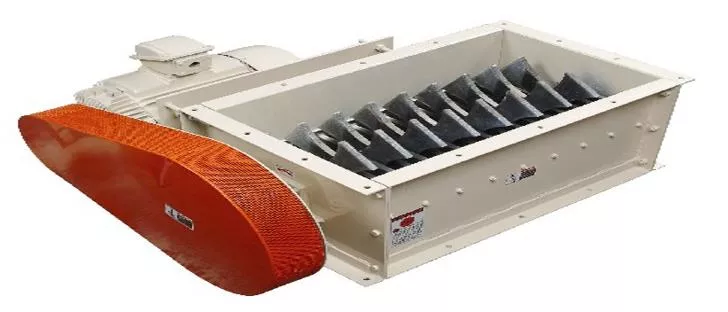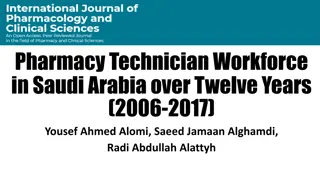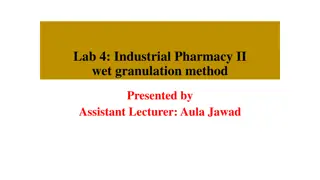Importance of Size Reduction in Pharmacy: Advantages and Disadvantages
Size reduction plays a crucial role in pharmacy by enhancing solubility, extraction rate, mixing quality, and more. However, there are also potential drawbacks such as changes in drug stability and flowability issues that need to be considered. Understanding the benefits and limitations of size reduction is essential for optimizing pharmaceutical processes.
Download Presentation

Please find below an Image/Link to download the presentation.
The content on the website is provided AS IS for your information and personal use only. It may not be sold, licensed, or shared on other websites without obtaining consent from the author. Download presentation by click this link. If you encounter any issues during the download, it is possible that the publisher has removed the file from their server.
E N D
Presentation Transcript
2-3 Lectures Lectures Size Reduction
Outline of the lecture: Size Reduction Definition Theory of size reduction Mechanism of size reduction Size reduction equipment 1. Hammer mill, (vertical, horizontal) 2. Cutting mill 3. End and edge runner mill 4. Fluidized energy mill 5. Ball mill and types 6. Oscillating granulator 7. Colloid mill
Definition of size reduction: It is the process that reduces large solid unit masses to smaller unit masses by mechanical means.
Importance of size Reduction in Pharmacy: Advantages: 1. Increase surface area which increase the solubility, and dissolution rate of material so enhance its bioavailability. 2. Improvement of extraction rate. 3. Improvement and increasing the drying rate. 4. Improve mixing of materials together so give less problems in uniformity of weight and contents of tablets. 5. Improve color and/or active ingredient dispersion in tablet excipient diluents. 6. Improve flowability of materials in tablet machine. 7. Control particle size distribution of a dry granulation or dry mix to minimize segregation while handling and tableting .
Disadvantages: 1. A possible change in polymorphic form of the active ingredient rendering it less or totally inactive or unstable. 2. Possible degradation of the drug as a result of heat build up during milling by oxidation or adsorption of unwanted moisture due to the increased surface area. 3. A decrease in bulk density may cause problems in the flowability of material. 4. A decrease in particle size may create static charge problems causing the agglomerate therefore effectively decreasing surface area. This may decrease the dissolution rate. small drug particles to
Size reduction is a rate process that depends on: 1. The size of the starting material, the feed. 2. Type of size reduction machine 3. The orientation of the material in the crushing machine. 4. The time of milling to which these materials are subjected
The principal means of accomplishing size reduction are: 1. Communion 2. Cutting 3. Shearing 4. Compression 5. Impaction 6. Attrition, Rubbing 7. Grinding, Trituration 8. Chappin
A flaw in a unit particle is a discontinuity or imperfection in the structure.
Compression at any point along the line below the yield value, the material will go back and returns to its original shape and this is called elastic deformation. However compression above the yield value will result in plastic deformation in which the substance break down and not go back to its original shape after removing stress.
Kinds of materials according to the process of size reduction: 1- Brittle 2- Fibrous 3- Hard
General hardness classification of some pharmaceutical materials: Material Talc Chalk Boric acid Cellulose Aspirin Lactose NH4CI Sucrose Dextrin Sorbitol Kaolin Magnesium oxide Calactate Amobarbital Hardness Soft Soft to brittle Soft Soft but Plastic Moderately hard to brittle Moderately hard to brittle Moderately hard to brittle Moderately hard to brittle Hard to brittle Hard Hard Hard Abrasive Hard Abrasive Very hard Abrasive
Mechanical Engineering Rittinger's law :This law states that the energy required for the crushing process is proportional to the surface sheared, (for fine grinding) Kick's law: The law states that energy required for crushing materials is proportional to the logarithm of the ratio between the initial (r1) and final diameters (r2) of the particles . Log (r1/r2)
Energy may be consumed in so many aspects in the size reduction process as: 1. Producing elastic deformation of particles before the occurrence of fractures, which is a waste energy. 2. Producing inelastic deformations which lead to size reduction and this is the wanted energy 3. Causing elastic distortion consequently failure of the equipment 4. Friction between the particles and the machine 5. Noise, heat and vibration in the plant.
There are factors associated with the nature of the material reduction as: a. Friability b. Structure which may be granular, Fibrous c. Hardness d. Stickiness e. Soapiness f. Moisture content
Grinding can be wet or dry when wet low speed mills are used Advantages of wet grinding (1) The power consumption is less by 20 - 30%. (2) The capacity of the plant is increased. (3) Removal of the product is facilitated and the amount of fines is reduced. (1) Dust formation is eliminated (2) The solids are more easily handled
Selection of size Reduction Equipment depends upon: A.Kind of material. B.Initial size of material. C.Final product particle size whether we need fine or large particles. D.Range of abrasion: some materials are abrasive so we use machine hard enough which withstand this abrasion effect. Hardness of materials are arranged in order of increasing hardness in the Mohr scale: 1- Talk 4- Fluorspar 2- Rock salt & gypsum 5- Apotite 3-Calcite 6- Felspar 7- Quartz 8- Topaz 10- Diamond 9- Carborundum E. Moisture content of material whether it is hydrous or anhydrous. F. Particle size distribution and shape. G. Structure, strength, friability, stickiness
Classification of size Reduction equipment: The oldest size reduction equipment is Busherstone. They are classified according to the products they intended to produce as follows:
Classification of size Reduction equipment 1. Coarse crushers: have no applications in pharmacy as blake jaw crusher, Dodge crusher, Gyraterycrusher and Rotary coal breaker 2. Intermediate crushers : Hammer mills Cutting mills Edge and end runner mills. 3. Fine crushers: - Ball mill - Fluid energy mill. - Oscillating granulator. 4. Colloidal mills.
Classification of size Reduction equipment All milling or Comminution equipment Consist of three main or basic parts: - 1. Feeding part. 2. Milling chamber. 3. Receiver. Some mills are also fitted with cyclones for classifying the partcles bysize.
Outline of the lecture: Size Reduction Definition Theory and mechanisms of size reduction Mechanism of size reduction Size reduction equipment 1. Hammer mill, (vertical, horizontal) 2. Cutting mill 3. End and edge runner mill 4. Fluidized energy mill 5. Ball mill and types 6. Oscillating granulator 7. Colloid mill
1. Hammer mill, (vertical, horizontal) 2. Cutting mill 3. End and edge runner mill 4. Fluidized energy mill 5. Ball mill and types 6. Oscillating granulator 7. Colloid mill Intermediate Crushing Fine Crushing For Liquids
Intermediate Crushing 1- Hammer Mill Hammer Mill: A, rotating disc; B, shaft; c, hammers; D, breaker plates; E, screen
There are 2 types of Hammer mill 1. Horizontal - shaft type. 2. Vertical - shaft type.
Advantages of Hammer mill: 1. Easy to set up or build 2. Easy to clean. 3. Small space requirement. 4. It has a wide range of the size of feed start. Disadvantages: 1. Possibility of clogging of screen 2. Heat build up during milling and cause degradation of product so not used for heat labile substances. 3. Mill and screen wear with abrasive materials
2-Cutting Mill: It is similar to Hammer mill but here, the hammer like knives or blades Processes: Cutting and shearing. It is used for fibrous materials, wet and dry materials and for dispersion of powder. (e.g. liquorices root). It is not used for hard, abrasive materials 3- Edge and End runner mills: The only advantage is using scraper which can be put on the edge. The feed is from the top or from side. Processes: shearing and attrition
Fine Crushers 1- Fluid Energy Mill It is rapid and very efficient method of reducing powders to 30 m and less with relatively narrow particle size distribution. Processes: Attrition and impaction. Principle of operation: A high-velocity air stream introduces the powder to the milling chamber by a venturi tube (a high - velocity air stream passing an opening containing the powder produces a vacuum in the opening and draws the powder into the air stream)
Milling takes place immediately because of the high - velocity collisions between particles suspended within the air steam. Grinding nozzles (usually 2-6 depending on the size of the mill) may be laced tangential or opposed to the initial powder flow path to increase the particle velocity resulting in higher impact energy. The air from the grinding nozzles transports the powder to a classifier which removes the smaller particles.
Schematic of fluid energy mill and particle collection system
The particle size depends on: 1. The configuration of the mill 2. Feed size 3. Position of the nozzles. 4. Design of the classifier. 5. Feed rate. If the feed rate is high larger particle size could be obtained If the feed rate is slow smaller particle size could be obtained
1. Heat -labile sbubstances can be milled with little danger of thermal degradation. This is because of the cooling effect of the air and rapid heat exchange between particles and air. 2. It produces very small and uniform distributed particles. 3. Inert gases can be used instead of air to minimize or Advantages: eliminate the oxidation of susceptible compounds which may occur with compressed air. Ultra-fine grinding Materials: Moderately hard 20 - 200 mesh gives 30-5 m or less. Materials not recommended for mill soft, tacky, fibrous Uses:
Ball Mill Types: 1. Batch 2. Continuous 3. Continuous closed circuit milling
http://upload.wikimedia.org/wikipedia/commons/4/4f/High-energy_ball_milling.gifhttp://upload.wikimedia.org/wikipedia/commons/4/4f/High-energy_ball_milling.gif http://upload.wikimedia.org/wikipedia/commons/c/c2/Ball_mill.gif http://upload.wikimedia.org/wikipedia/commons/thumb/1/1d/8000M_Mixer_Mill_%28open%29_incl_accessories.jpg/220px-8000M_Mixer_Mill_%28open%29_incl_accessories.jpg
Ball Mill A. Batch: It is a cylindrical shell filled to about 1/2 its volume with grinding media with different sizes. The shell rotates on its central axis by means of motor- driven rollers on which it rests.
B- Continuous: It is a conical shell with grinding media of different sizes. Feed enters from the hollow end of the mill and milled material exits through a grating or small ports of the opposite end.
Harding Mill Conical mill chamber Grating Feedstock in Milled product out Grinding media
Another classification of ball mills: 1- Simple ball mill 2- Pebble mill 3-Tube mill 4- Compound ball mill 5- Hardinage mill 6- Rod mill Discharge end Hardinage mill Feed end
C. Continuous closed -circuit milling: It is arranged using the continuous mill with a gas or liquid classifying system.
Air and feed enters through the opening at end of the mill. The large feedstack drops into the milling zone and the smaller particles become entrained in the air stream flowing through the mill and exiting through the opposite end to a particle classifier. The classifier removes the smallest particles while the larger particles are recycled to the mill inlet for further size reduction.
At and above the critical speed, the mill is said to be centrifuging and grinding of material not occur. Therefore, milling must be carried out below the critical speed of the mill at some optimum speed where the balls are carried to the highest point in the chamber without centrifuging.
This speed is dependent on: 1. Chamber size 2. Grinding - media size (i.e. Ball size) 3. Shape, density and size distribution of material. 4. Amount of material used in the mill. Factors influencing the size of the product in the ball mill: (1) The rate of feed (2) Weight of balls (3) The diameter of the balls (4) The slope of the mill (5) Discharge freedom (6) The speed.
Advantage of the ball mill: It is used for milling highly abrasive materials. Disadvantages: 1. Difficult to clean 2. Long milling time (i.e. time consuming) 3. High energy requirements and high cost.
1. Hammer mill, (vertical, horizontal) 2. Cutting mill 3. End and edge runner mill 4. Fluidized energy mill 5. Ball mill and types 6. Oscillating granulator 7. Colloid mill Intermediate Crushing Fine Crushing For Liquids
































